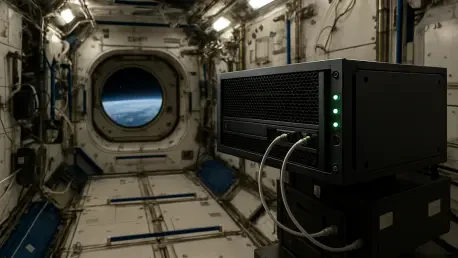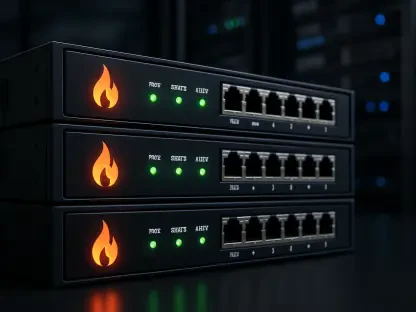Picture a world where cutting-edge data processing happens not just on Earth, but 400 kilometers above, in the vacuum of space aboard the International Space Station (ISS). A pioneering project has pushed the boundaries of technology with the launch of the AxDCU-1, an orbital data center prototype, by Axiom Space in partnership with Red Hat during SpaceX’s 33rd commercial resupply mission on August 24. Supported by the ISS National Laboratory, this ambitious experiment seeks to determine whether terrestrial data center technologies can endure the extreme conditions of low Earth orbit (LEO). This isn’t just a test of hardware; it’s a bold vision to transform how data is managed in space, reducing dependency on slow and expensive satellite downlinks while meeting the escalating needs of the commercial space sector. If successful, this could mark a turning point for space research and open new possibilities for computing in environments far beyond the planet’s surface.
The Challenges of Space-Based Computing
Orbital Connectivity Constraints
The harsh reality of computing in space begins with the fundamental challenge of connectivity, shaped by the ISS’s rapid orbit around Earth every 90 minutes. This relentless cycle creates narrow and often unpredictable windows for communication with ground stations, rendering traditional cloud computing models—dependent on constant connectivity—nearly impossible to implement. The resulting delays and bandwidth limitations mean that transmitting large volumes of data back to Earth for processing is not only costly but also inefficient. Edge computing emerges as a critical solution by enabling data to be processed locally in orbit, significantly cutting down the need for constant communication with terrestrial systems. The AxDCU-1 prototype is designed to tackle this issue head-on, offering a glimpse into a future where space-based systems can operate with greater independence and speed, unshackled from the constraints of intermittent ground links.
Beyond the technical hurdles of connectivity lies a broader context driving the urgency of such innovations: the explosive growth of the commercial space economy. As private companies, research institutions, and even governments ramp up activities in orbit, the demand for robust data processing capabilities in space has surged. Missions are becoming more complex, generating vast datasets that need immediate analysis to inform decisions or adjust experiments. The collaboration between Axiom Space and Red Hat represents a pivotal effort within a larger wave of initiatives aimed at extending data center technology beyond Earth’s atmosphere. This push is not merely about overcoming current limitations but also about building a foundation for a future where space operations are as data-driven and efficient as their terrestrial counterparts, ensuring that the expanding space economy has the infrastructure to support its ambitions.
Environmental and Operational Barriers
Operating technology in space introduces a host of environmental challenges that terrestrial systems rarely encounter, such as exposure to radiation, extreme temperature fluctuations, and the absence of gravity. These conditions can degrade hardware performance and disrupt data integrity if not addressed with specialized designs. The AxDCU-1 must withstand these harsh elements while maintaining consistent operation, a feat that requires innovative engineering to protect sensitive components. Beyond physical durability, the system also faces the operational constraint of limited power availability in orbit, necessitating energy-efficient solutions that can function without frequent human intervention. This project serves as a critical testbed for proving that data center technologies can be adapted to such an unforgiving environment, potentially setting new standards for resilience in space computing.
Another layer of complexity arises from the logistical barriers inherent to space missions, including the high cost and infrequency of launches to the ISS. Every piece of equipment sent into orbit must be meticulously planned and optimized, as resupply or repairs are neither quick nor cheap. The AxDCU-1’s design prioritizes autonomy to mitigate these issues, ensuring it can handle updates and maintenance with minimal data transmission to Earth. This focus on self-sufficiency is vital for reducing operational dependencies and costs, especially in an environment where physical access is limited to rare mission windows. Success in overcoming these barriers could not only validate the prototype’s capabilities but also inspire confidence in deploying similar systems to other space platforms, paving the way for a more sustainable approach to computing beyond Earth.
Technological Innovations in Orbit
The Power of AxDCU-1
At the heart of this groundbreaking initiative is the AxDCU-1, a sophisticated orbital data center equipped with cutting-edge technology to navigate the unique demands of space. Powered by Red Hat Device Edge and MicroShift—a lightweight Kubernetes distribution—this system is engineered to run containerized workloads efficiently, even in the void of low Earth orbit. Key features like self-healing capabilities and automated rollbacks ensure that the system can recover from disruptions without manual input, a necessity given the communication blackouts caused by the ISS’s orbit. Additionally, delta updates, which transmit only the modified portions of software, minimize bandwidth usage, addressing one of the core limitations of space operations. This combination of autonomy and efficiency positions the AxDCU-1 as a significant leap forward from traditional satellite processors, demonstrating how terrestrial tech can be tailored for extraterrestrial challenges.
The impact of such technological advancements extends directly to the researchers aboard the ISS, who have long grappled with the inefficiencies of data handling in orbit. Historically, experimental data had to be sent back to Earth for analysis, a process that introduced significant delays and squandered valuable time in the microgravity environment. With the AxDCU-1’s local processing capabilities, scientists can now analyze data in real time, allowing for immediate adjustments to experiments. This is particularly transformative for data-intensive fields like life sciences and biomedical research, where timely insights can drastically enhance outcomes. By enabling on-the-fly iterations, this technology maximizes the scientific return on every minute spent in space, potentially accelerating discoveries that could benefit both space exploration and terrestrial applications in health and technology.
Adapting Terrestrial Tech for Space
Adapting familiar terrestrial technologies like Kubernetes for the space environment is no small feat, requiring a deep understanding of both the software’s potential and the unique constraints of orbit. The use of MicroShift in the AxDCU-1 showcases how containerization—a staple in modern data centers—can be scaled down to operate in resource-limited settings without sacrificing functionality. This lightweight approach ensures that the system remains agile, capable of managing complex workloads while consuming minimal power and bandwidth. Moreover, the ability to remotely update and manage the system through over-the-air patches is a critical innovation, as it reduces the need for physical intervention in an environment where access is severely restricted. This adaptation highlights a broader trend of leveraging proven Earth-based solutions to solve extraterrestrial problems, bridging the gap between two seemingly disparate worlds.
The significance of these adaptations lies not only in their immediate application but also in the precedent they set for future space missions. By proving that terrestrial technologies can function reliably under the extreme conditions of low Earth orbit, the AxDCU-1 project validates a scalable model for computing infrastructure in space. This success could encourage further investment in similar systems, fostering a new ecosystem of space-ready tech that builds on existing frameworks rather than starting from scratch. Additionally, the focus on autonomy and resilience in the system’s design addresses long-standing concerns about operational reliability in orbit, offering a blueprint for other industries looking to push technology into uncharted territories. As these innovations mature, they could redefine the boundaries of where and how computing power is deployed, both in space and beyond.
Future Implications and Broader Impact
Beyond the ISS
The implications of the AxDCU-1 project extend far beyond the confines of the ISS, offering promising applications for future commercial space endeavors. As plans for independent space stations like Axiom Station take shape, the need for scalable, self-sustaining computing infrastructure becomes paramount. The lessons learned from this prototype could directly inform the design of robust systems capable of supporting long-term missions with minimal reliance on Earth-based resources. Such advancements are crucial for creating space habitats that function as independent ecosystems, equipped to handle everything from daily operations to complex scientific research. By laying this groundwork, the current initiative serves as a vital stepping stone toward a future where space infrastructure rivals the sophistication and reliability of terrestrial networks, enabling humanity to live and work in orbit with unprecedented efficiency.
Equally compelling is the potential for space-driven innovations to impact life back on Earth, particularly in remote or resource-constrained environments. The technologies developed to withstand the harsh conditions of orbit—radiation, isolation, and power limitations—could be adapted to enhance computing in areas with limited connectivity, such as disaster zones or rural regions. Autonomous systems and edge AI, refined through projects like AxDCU-1, might enable critical infrastructure to operate independently during crises, ensuring continuity of essential services. This dual-purpose potential underscores the broader value of space exploration, where solutions born out of necessity in orbit find meaningful applications on the ground, improving resilience and access to technology in some of the planet’s most challenging settings.
Diverse Needs in Space Computing
The space data market is rapidly evolving, revealing a spectrum of needs that edge computing is uniquely positioned to address, as demonstrated by the AxDCU-1 initiative. While this project focuses on low-latency applications critical for real-time processing aboard the ISS, other efforts, such as lunar data storage projects by companies like Lonestar Data Holdings, prioritize security through high-latency setups due to the vast distance from Earth. This contrast highlights the diversity within the emerging space computing landscape, where different missions and environments demand tailored approaches. Edge computing serves as a unifying solution, adaptable enough to support both immediate, responsive tasks in orbit and long-term, secure storage on the Moon, reflecting the multifaceted nature of data challenges in space.
As the commercial space sector continues to grow, the varied applications of space-based computing underscore the importance of flexible, innovative technologies like those tested in the AxDCU-1. The ability to cater to distinct operational demands—whether enabling rapid decision-making in low Earth orbit or safeguarding critical data on lunar surfaces—demonstrates the versatility required to sustain this burgeoning industry. Furthermore, the success of such initiatives could spur collaboration across sectors, encouraging the development of standardized platforms that can be customized for specific space environments. This adaptability not only addresses current gaps in space infrastructure but also anticipates future needs, ensuring that computing power remains a cornerstone of exploration and commerce as humanity pushes deeper into the cosmos.
Building a Legacy in Space Tech
Reflecting on the journey of the AxDCU-1, it’s clear that this project marked a historic milestone in redefining data processing 400 kilometers above Earth. The collaboration between Axiom Space and Red Hat tackled formidable challenges like bandwidth scarcity and environmental extremes, proving that edge computing could indeed flourish in orbit. Its impact was felt in the enhanced research capabilities aboard the ISS, where real-time analysis became a reality for scientists. Looking ahead, the next steps involve scaling these innovations for upcoming commercial space stations and refining them for terrestrial use in remote areas. Continued investment and research are essential to address remaining hurdles such as launch costs and hardware durability. By building on this foundation, the space tech community can ensure that computing power becomes as ubiquitous in orbit as on Earth, shaping a future where the boundaries of data handling are truly limitless.









